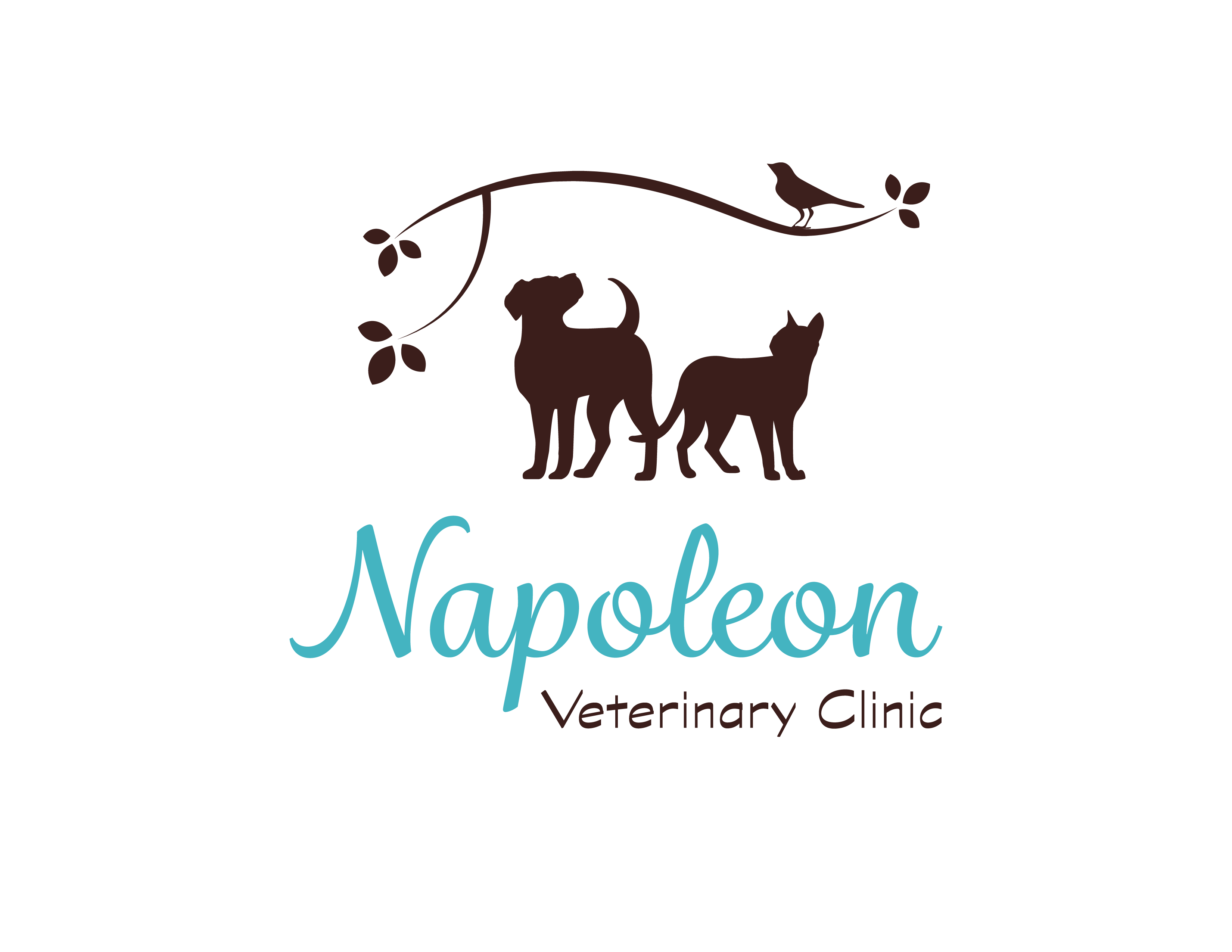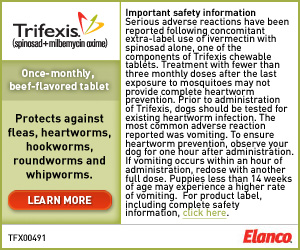
Caring for Newborn Puppies
What do you need to do to care for the newborn puppies?
For the next two months, even if everything went smoothly with the birth, you have a lot of work ahead of you that needs done. After the birthing process, clean up the mother as much as possible without upsetting her. Frequently, remove any soiled newspaper or bedding from her whelping box. Normally the new mother will spend most of her time with the puppies. For the first few days it may be difficult to get her to leave the “nest” even to go to the bathroom. However, it is important that she continues to urinate/defecate normally. If she refuses to go out on her own, it is acceptable to put a leash and collar on her and take her out for a short period of time. She will only want to be out for a few minutes but this is a great opportunity for you to clean up the bed and make the whelping box safe for the puppies. Before she returns to the puppies, check her teats (nipples) and vulva to make sure there are no problems such as bleeding, foul smelling discharges, or any other abnormalities.
What sort of problems should you look for in the mother?
Check the vulva to see if there is much discharge. The discharge is normally a greenish-black color and, if she has not expelled all her afterbirths during birthing, it may be quite copious. However, it should lessen significantly after 24 – 48 hours. You will also want to check her nipples to make sure that none are swollen, red, hot, hard, or tender. If you find any abnormalities or have any concerns about the mother or puppies, contact us at 419-592-6876.
How often should you be checking on the puppies?
It is a good idea, especially with a first time mother, to check on the puppies every few hours to make sure they are all suckling and are warm and content. Any puppies that are crying or appear to be cold should be placed on the inguinal (hind) teats and checked frequently to make sure they are not being pushed away by the other puppies. The teats between the hind legs usually give the most milk.
When should you have a puppies’ tails/dew claws removed?
Removing the dewclaws and/or tail docking is done between 3-5 days old. Dew claw removal is commonly done in order to avoid future problems that can arise from dew claws snagging on objects. Tail docking is an elective cosmetic procedure performed on certain breeds of dogs in order to achieve a specific look. Such breeds include the Rottweiler, Doberman pinscher, Boxer, Miniature pinscher, Schnauzer, Toy Fox terrier, Corgi, Poodle, and Schipperke.
What should you do if the mother refuses to stay with the puppies?
This is common for pets that are closely attached to their owners. If the mother will not stay with her puppies, try locating her and the puppies so she can be nearer to you. Make sure the puppies are kept warm. They cannot maintain their own body heat for a week or two after birth. As long as puppies stay close to their mother, the room temperature is not too crucial. However, if the mother leaves her puppies alone, they need to be provided with an outside source of warmth. During the first 4 days of life, the environmental temperature where the puppies are kept should be maintained at 85-90° F (29.5-32°C). The temperature may then be gradually decreased to approximately 80°F (26.7°C) by the seventh to tenth day and then to about 72°F (22.2°C) by the end of the fourth week of life. It is not necessary to heat the entire room to the temperatures. Heating the area over the whelping box with the aid of a heat lamp is usually all that is necessary. The larger the litter the lower the environmental temperature needs to be. This is because the puppies will huddle together and keep each other warm. The puppies’ behavior and condition gives an indication whether they are comfortable and healthy. If they are warm and content they will be quiet and gaining weight, otherwise they will be restless and crying.
Is it necessary to keep the mother and puppies in subdued light?
In the wild, dogs will find a secluded whelping place, usually a dark or sheltered spot. Some dogs, if they feel their puppies are too exposed, may become anxious and start carrying them around the house. Placing a blanket over part of the top of the whelping box or providing and enclosed crate may resolve this problem. Some females are more anxious than others, particularly with their first litter. They may try to hide their puppies, even from their owners. If the mother does not like the place you have selected for her, try to compromise. If she is still unsettled, contact our office since stress can affect the mother’s milk supply and may cause problems with the puppies.
How you can help teach a puppy to use the bathroom:
During their first few weeks of life, puppies are unable to urinate and defecate on their own. Mothers instinctively stimulate their babies to excrete waste through licking. If you are raising puppies without a mother dog, you will have to assume this responsibility—luckily, you can use your hands instead of your tongue! Dip a soft washcloth or a piece of gauze in warm water and gently massage the anal and urinary regions after feeding. The warmth, texture and movement mimic a mother dog’s tongue. It is vital that you do this. Puppies begin excreting on their own at about three to four weeks of age.
Is it true that some female dogs will actually kill and eat their puppies?
In the wild, a dog with puppies is vulnerable to all sorts of predators. If the puppies become vocal and distressed, the danger of attack by a predator increases. The primeval protective instinct will sometimes surface in even the gentlest pet. This occurs in some breeds more than others. Killing the puppies and sometimes eating them is a method of averting a perceived danger.
How to tell if there is a problem with the puppies:
During the first two weeks of life, before their eyes open, puppies should feed and sleep for at least 90% of the time. Puppies should be weighed often. Electronic kitchen or postal scales can be used to provide accurate weights of the puppies. This gives a guide to their condition and progress. If you are weighing the puppies regularly (once a day is recommended), there should be a consistent increase in weight. If any of the puppies appear restless or noisy, this may indicate a lack of nourishment or infection. Weight loss in a puppy is a cause for concern. Therefore, keep careful records of your newborn puppies’ weights. If all the puppies appear similar in looks, you can identify the puppies by using non-toxic, permanent marker pens to mark each one on the abdomen. You can use a variety of colors. If you are concerned about any of the puppies, please contact us immediately.
How to know if the mother’s milk supply if adequate:
A content litter of plump puppies is the best indicator that the mother is producing an adequate milk supply. Any puppies that appear restless and do not have fat tummies will benefit from supplemental feeding one to three times a day. A good milk replacer to feed is Esbilac. It is a complete food source for orphaned or rejected puppies, nursing puppies needing supplemental feedings, and adult dogs requiring extra nutrients. This easy-to-digest, nutritional formula closely matches the vitamins, minerals, proteins, fat, and carbohydrates found in the dam’s milk to ensure proper development and growth. It is important that any supplementary food be fed at the correct temperature. One rule of thumb is to drop some of the warmed fluid on your arm. It should feel about the same as your normal body temperature.
When Should Puppies Have Their First Vet Checkup?
Assuming the pups appear healthy, we recommend that they receive their first round of standard vaccinations at 6 weeks of age. During this initial health checkup, we will analyze a fecal sample for any internal parasites, perform a physical examination, and start the puppies on their recommended vaccine schedule.
However, you should contact us immediately if a puppy exhibits any of the following symptoms:
| Lack of appetite | Swollen eyes or eye discharge | Coughing/wheezing |
| Poor weight gain | Nasal discharge | Constant crying |
| Vomiting | Inability to pass urine or stool | Pale gums |
| Diarrhea | Difficulty breathing |
Is it true that the mother may develop infection/inflammation of the breasts without warning?
Inflammation and infection of the breasts is called acute mastitis and it can occur very quickly. This is the reason the mother’s mammary glands should be checked regularly for any abnormal discharge, inflammation, tenderness, of hardness. If the mother does not produce milk of her milk is infected, the puppies will not be nourished. Puppies that are not being fed enough will cry constantly and fail to gain weight. If this occurs, an entire litter can die within 24-48 hours. Total replacement feeding via a foster mother of milk replacer products is necessary.
Is this the same as “milk fever”?
No. Mastitis in an infection of the mammary glands. Eclampsia or milk fever is due to a depletion of calcium in the blood of the mother due to heavy milk production and is not due to infection. Eclampsia occurs most commonly when the puppies are 3-5 weeks of age and the mother is producing the most milk. Eclampsia is not due to and overall lack of calcium; it merely indicates that she cannot mobilize sufficient supplies of stored calcium quickly enough to meet her metabolic needs. Females that are particularly good mothers, especially attentive to their puppies, seem to be more likely to develop eclampsia. Signs of eclampsia include tremors, weakness and a form of paralysis called puerperal tetany characterized by stiff limbs and an inability to stand or walk.
How to tell if “milk fever” is starting in your pet:
Eclampsia is a true medical emergency! Initial signs are subtle. The female may be restless or panting a lot and you may notice she is moving more stiffly. This soon progresses to muscle spasms affecting the whole body, which can quickly progress to convulsing. If you suspect eclampsia is developing, prevent the pups from suckling and contact our office immediately. Treatment involves injections of calcium and other medications. If treated quickly, recovery is usually rapid and complete. However, milk fever may occur with each subsequent litter, and should factor into any decision about breeding and affected dog.

